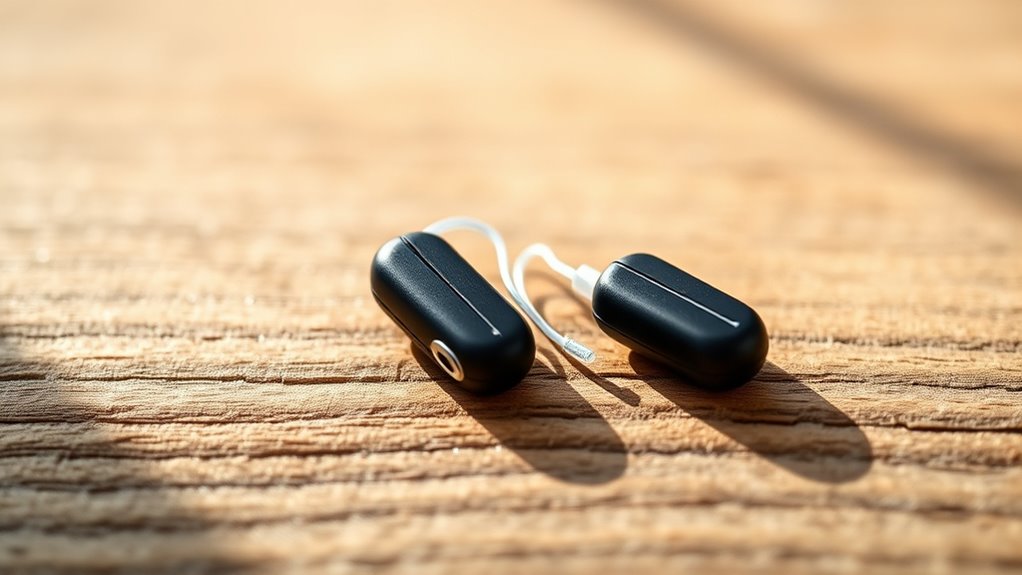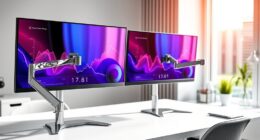Self-fitting OTC hearing aids are regulated as a distinct category to guarantee safety and performance while allowing you to purchase and adjust devices without a clinical visit. These devices are designed with user-friendly setup features and guided instructions, making them accessible and affordable. While they meet safety standards, understanding their features and limitations helps set proper expectations. If you want to learn more about how these regulatory standards impact you, keep going for details.
Key Takeaways
- Self-fitting OTC hearing aids are regulated as over-the-counter medical devices, not requiring traditional clinical approval.
- They must meet safety, performance, and labeling standards set by regulatory agencies like the FDA.
- These devices are designed for consumer self-selection, fitting, and adjustment without a healthcare provider.
- Users should review product labels and instructions to understand device capabilities and limitations.
- Regulatory oversight ensures safety but does not guarantee the same efficacy as clinician-fitted hearing aids.

Self-fitting over-the-counter (OTC) hearing aids are transforming how people access hearing assistance by allowing you to purchase and set up devices without a visit to a specialist. This regulatory shift makes hearing aids more accessible and affordable, but it also brings important considerations regarding cost and user training. Since OTC hearing aids are designed for self-fitting, they typically come with guided setup processes that help you adjust the device to your hearing needs. However, understanding the cost considerations is *crucial* because these devices often cost *significantly* less than traditional hearing aids that require professional fitting and ongoing services. While the lower price point makes hearing assistance more attainable for many, you should be aware that some users might need additional support or adjustment over time. *It’s essential to* weigh the initial savings against potential costs for future adjustments or troubleshooting, especially if the self-fitting process isn’t as straightforward as expected.
User training plays a *vital* role in *guaranteeing* you get the most out of OTC hearing aids. Since these devices are intended for self-directed setup, manufacturers typically include detailed instructions, tutorials, or digital guides. Still, you might find the process challenging initially, especially if you’re unfamiliar with hearing technology. Taking the time to carefully read and follow the user instructions can make a *meaningful* difference in achieving *ideal* sound quality and comfort. Some OTC hearing aids also offer smartphone apps that simplify the fitting process and provide ongoing support, but it’s important to familiarize yourself with these tools beforehand. If you encounter difficulties, having a basic understanding of the device’s features and troubleshooting steps can save you frustration and *guarantee* your hearing aid functions effectively. Additionally, research shows that the effectiveness of self-fitting hearing aids can be enhanced by understanding how to optimize indoor sound quality, which can be affected by placement and room acoustics.
Regulatory oversight for OTC hearing aids aims to strike a balance between accessibility and safety. These devices are regulated to ensure they meet certain standards for safety and performance, but they are not subject to the same clinical approval process as traditional hearing aids. This means that while they can be purchased over the counter, you should still approach them with informed expectations. Carefully reading product labels, understanding the features, and considering your specific hearing needs will help you select an appropriate device. Being proactive about user training and understanding the cost considerations can make the *transition* to OTC hearing aids smoother, ultimately helping you enjoy clearer hearing without the need for frequent visits to professionals.
Frequently Asked Questions
How Do Self-Fitting OTC Hearing Aids Compare in Cost to Traditional Models?
Self-fitting OTC hearing aids generally cost less than traditional models, making them more affordable for many users. The cost comparison shows significant savings due to reduced manufacturing and distribution expenses. Affordability factors include fewer middlemen and direct-to-consumer sales, which help lower prices. You’ll find that self-fitting OTC devices offer a budget-friendly option without sacrificing essential features, making hearing assistance more accessible for those with mild to moderate hearing loss.
Can Self-Fitting OTC Hearing Aids Fully Replace Professional Audiologist Services?
Imagine holding a key to better hearing in your hand. Self-fitting OTC hearing aids can offer user customization and remote diagnostics, but they might not fully replace professional audiologist services. While they help improve hearing, they lack the nuanced adjustments and personalized care an audiologist provides. For complex issues or ongoing support, consulting a professional ensures ideal results, much like trusting a skilled guide on your journey to better hearing.
What Safety Regulations Oversee the Manufacturing of OTC Hearing Aids?
You should know that manufacturing standards and safety certifications oversee OTC hearing aids. These devices must meet strict safety regulations set by authorities like the FDA, ensuring they are safe for consumers. Manufacturers must comply with quality control protocols, and products often require certifications such as CE or FCC, verifying they meet specific safety and performance criteria. This oversight helps protect users from potential risks associated with these hearing aids.
How Effective Are Self-Fitting OTC Hearing Aids for Severe Hearing Loss?
Imagine trying to tune a guitar, but the strings are too tight; self-fitting OTC hearing aids aren’t always effective for severe hearing loss. While they provide useful auditory amplification and device customization for mild to moderate cases, severe loss often requires professional fitting. You might find these aids helpful, but for profound hearing issues, consulting an audiologist guarantees ideal performance and safety.
Are There Specific Training Requirements for Consumers to Operate These Devices?
You don’t need special training to operate self-fitting OTC hearing aids. These devices are designed for user-friendly operation, often including guided setup and instructions for user training. Most models have simple controls and calibration features that help you customize the fit and sound. However, it’s beneficial to read the user manual carefully and follow the guidance provided to guarantee proper device operation and peak hearing assistance.
Conclusion
Imagine a world where anyone with hearing loss can instantly regain crystal-clear sound, no doctors needed, thanks to self-fitting OTC hearing aids. This revolutionary category could change lives overnight, making silence a thing of the past. You won’t believe how quickly you’ll rediscover the joy of conversation and connection. Don’t wait for tomorrow—embrace this groundbreaking innovation today and open a world of endless sound and endless possibilities!











